Implementing Sustainable Practice: Nissan's Approach to Air Quality
VerifiedAdded on 2022/11/25
|12
|2934
|71
Report
AI Summary
This report analyzes Nissan's approach to implementing sustainable practices, with a primary focus on reducing air pollution. The report begins with an executive summary and an introduction to sustainable development. It then delves into Nissan's current sustainability practices, motor vehicle pollution, and strategies for reducing air pollution, including selecting fuel-efficient vehicles, switching to electric vehicles, and cleaner fuel options. The report also explores Nissan's engagement with key stakeholders, particularly shareholders and investors, and discusses the role of research and development in new energy vehicles, including fuel cell cars and battery electric cars. The report emphasizes the importance of system design and integration for the successful implementation of these technologies. Overall, the report provides a comprehensive overview of Nissan's efforts to promote sustainable mobility and reduce its environmental impact.
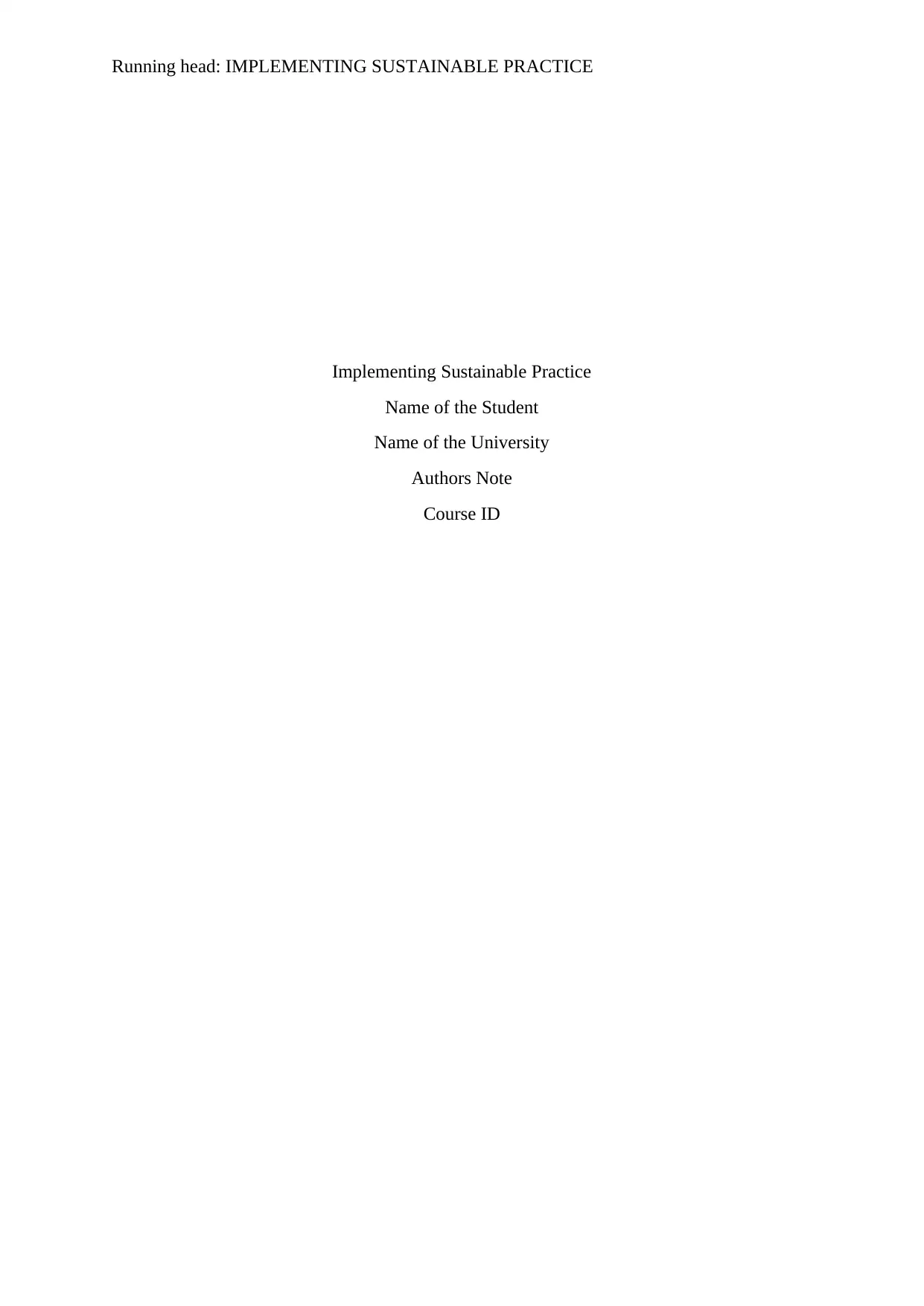
Running head: IMPLEMENTING SUSTAINABLE PRACTICE
Implementing Sustainable Practice
Name of the Student
Name of the University
Authors Note
Course ID
Implementing Sustainable Practice
Name of the Student
Name of the University
Authors Note
Course ID
Paraphrase This Document
Need a fresh take? Get an instant paraphrase of this document with our AI Paraphraser
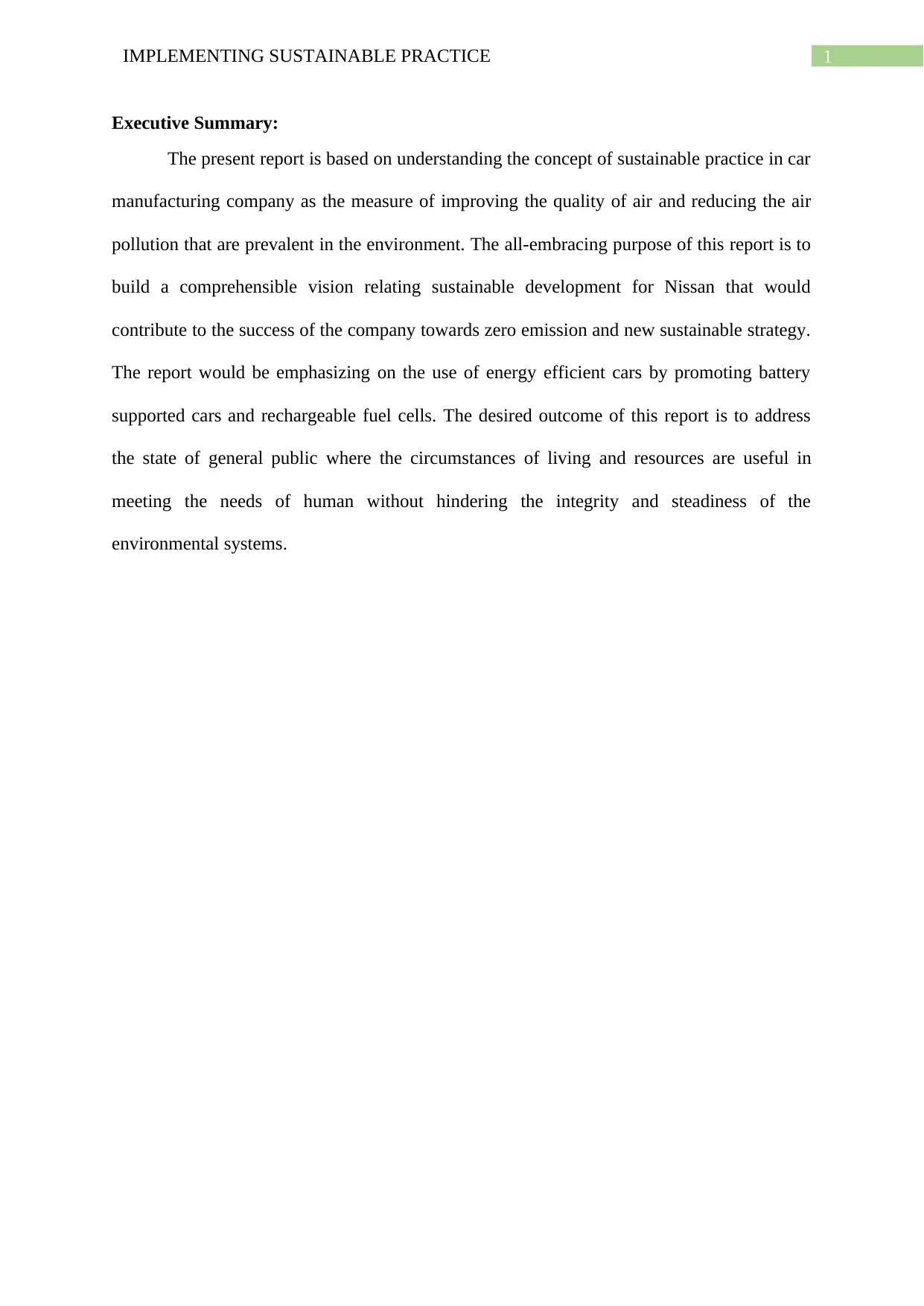
1IMPLEMENTING SUSTAINABLE PRACTICE
Executive Summary:
The present report is based on understanding the concept of sustainable practice in car
manufacturing company as the measure of improving the quality of air and reducing the air
pollution that are prevalent in the environment. The all-embracing purpose of this report is to
build a comprehensible vision relating sustainable development for Nissan that would
contribute to the success of the company towards zero emission and new sustainable strategy.
The report would be emphasizing on the use of energy efficient cars by promoting battery
supported cars and rechargeable fuel cells. The desired outcome of this report is to address
the state of general public where the circumstances of living and resources are useful in
meeting the needs of human without hindering the integrity and steadiness of the
environmental systems.
Executive Summary:
The present report is based on understanding the concept of sustainable practice in car
manufacturing company as the measure of improving the quality of air and reducing the air
pollution that are prevalent in the environment. The all-embracing purpose of this report is to
build a comprehensible vision relating sustainable development for Nissan that would
contribute to the success of the company towards zero emission and new sustainable strategy.
The report would be emphasizing on the use of energy efficient cars by promoting battery
supported cars and rechargeable fuel cells. The desired outcome of this report is to address
the state of general public where the circumstances of living and resources are useful in
meeting the needs of human without hindering the integrity and steadiness of the
environmental systems.
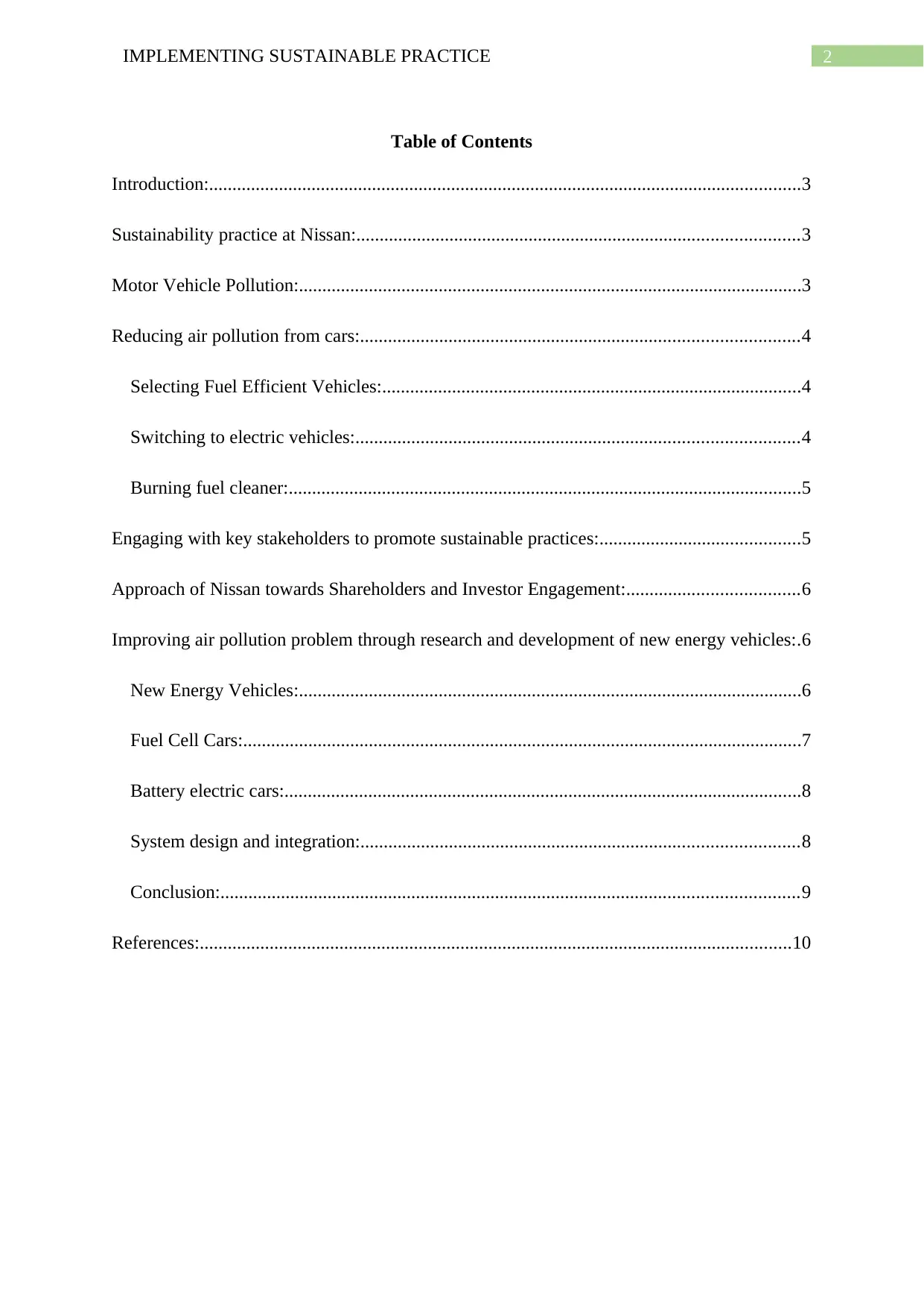
2IMPLEMENTING SUSTAINABLE PRACTICE
Table of Contents
Introduction:...............................................................................................................................3
Sustainability practice at Nissan:...............................................................................................3
Motor Vehicle Pollution:............................................................................................................3
Reducing air pollution from cars:..............................................................................................4
Selecting Fuel Efficient Vehicles:..........................................................................................4
Switching to electric vehicles:...............................................................................................4
Burning fuel cleaner:..............................................................................................................5
Engaging with key stakeholders to promote sustainable practices:...........................................5
Approach of Nissan towards Shareholders and Investor Engagement:.....................................6
Improving air pollution problem through research and development of new energy vehicles:.6
New Energy Vehicles:............................................................................................................6
Fuel Cell Cars:........................................................................................................................7
Battery electric cars:...............................................................................................................8
System design and integration:..............................................................................................8
Conclusion:............................................................................................................................9
References:...............................................................................................................................10
Table of Contents
Introduction:...............................................................................................................................3
Sustainability practice at Nissan:...............................................................................................3
Motor Vehicle Pollution:............................................................................................................3
Reducing air pollution from cars:..............................................................................................4
Selecting Fuel Efficient Vehicles:..........................................................................................4
Switching to electric vehicles:...............................................................................................4
Burning fuel cleaner:..............................................................................................................5
Engaging with key stakeholders to promote sustainable practices:...........................................5
Approach of Nissan towards Shareholders and Investor Engagement:.....................................6
Improving air pollution problem through research and development of new energy vehicles:.6
New Energy Vehicles:............................................................................................................6
Fuel Cell Cars:........................................................................................................................7
Battery electric cars:...............................................................................................................8
System design and integration:..............................................................................................8
Conclusion:............................................................................................................................9
References:...............................................................................................................................10
⊘ This is a preview!⊘
Do you want full access?
Subscribe today to unlock all pages.

Trusted by 1+ million students worldwide
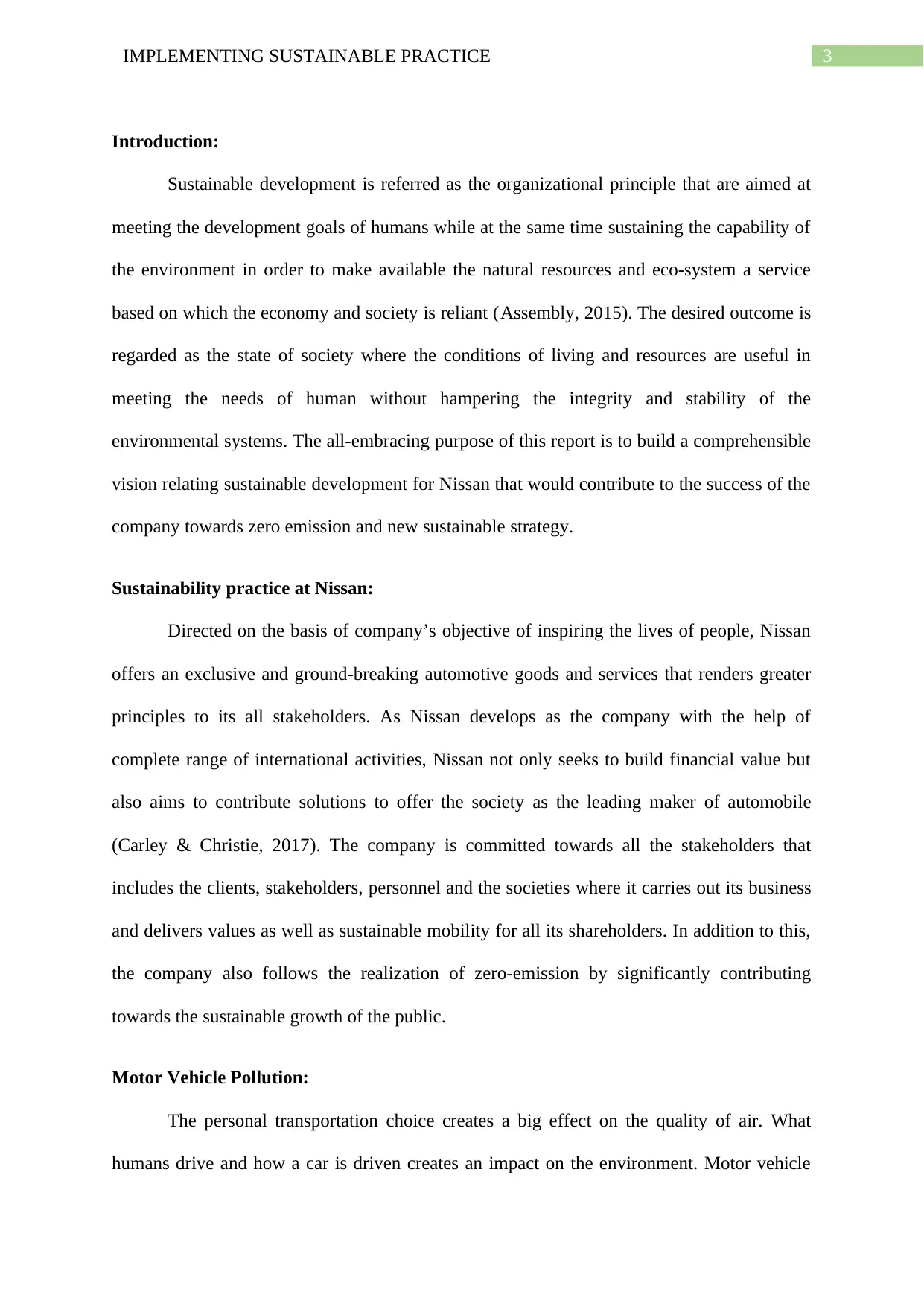
3IMPLEMENTING SUSTAINABLE PRACTICE
Introduction:
Sustainable development is referred as the organizational principle that are aimed at
meeting the development goals of humans while at the same time sustaining the capability of
the environment in order to make available the natural resources and eco-system a service
based on which the economy and society is reliant (Assembly, 2015). The desired outcome is
regarded as the state of society where the conditions of living and resources are useful in
meeting the needs of human without hampering the integrity and stability of the
environmental systems. The all-embracing purpose of this report is to build a comprehensible
vision relating sustainable development for Nissan that would contribute to the success of the
company towards zero emission and new sustainable strategy.
Sustainability practice at Nissan:
Directed on the basis of company’s objective of inspiring the lives of people, Nissan
offers an exclusive and ground-breaking automotive goods and services that renders greater
principles to its all stakeholders. As Nissan develops as the company with the help of
complete range of international activities, Nissan not only seeks to build financial value but
also aims to contribute solutions to offer the society as the leading maker of automobile
(Carley & Christie, 2017). The company is committed towards all the stakeholders that
includes the clients, stakeholders, personnel and the societies where it carries out its business
and delivers values as well as sustainable mobility for all its shareholders. In addition to this,
the company also follows the realization of zero-emission by significantly contributing
towards the sustainable growth of the public.
Motor Vehicle Pollution:
The personal transportation choice creates a big effect on the quality of air. What
humans drive and how a car is driven creates an impact on the environment. Motor vehicle
Introduction:
Sustainable development is referred as the organizational principle that are aimed at
meeting the development goals of humans while at the same time sustaining the capability of
the environment in order to make available the natural resources and eco-system a service
based on which the economy and society is reliant (Assembly, 2015). The desired outcome is
regarded as the state of society where the conditions of living and resources are useful in
meeting the needs of human without hampering the integrity and stability of the
environmental systems. The all-embracing purpose of this report is to build a comprehensible
vision relating sustainable development for Nissan that would contribute to the success of the
company towards zero emission and new sustainable strategy.
Sustainability practice at Nissan:
Directed on the basis of company’s objective of inspiring the lives of people, Nissan
offers an exclusive and ground-breaking automotive goods and services that renders greater
principles to its all stakeholders. As Nissan develops as the company with the help of
complete range of international activities, Nissan not only seeks to build financial value but
also aims to contribute solutions to offer the society as the leading maker of automobile
(Carley & Christie, 2017). The company is committed towards all the stakeholders that
includes the clients, stakeholders, personnel and the societies where it carries out its business
and delivers values as well as sustainable mobility for all its shareholders. In addition to this,
the company also follows the realization of zero-emission by significantly contributing
towards the sustainable growth of the public.
Motor Vehicle Pollution:
The personal transportation choice creates a big effect on the quality of air. What
humans drive and how a car is driven creates an impact on the environment. Motor vehicle
Paraphrase This Document
Need a fresh take? Get an instant paraphrase of this document with our AI Paraphraser
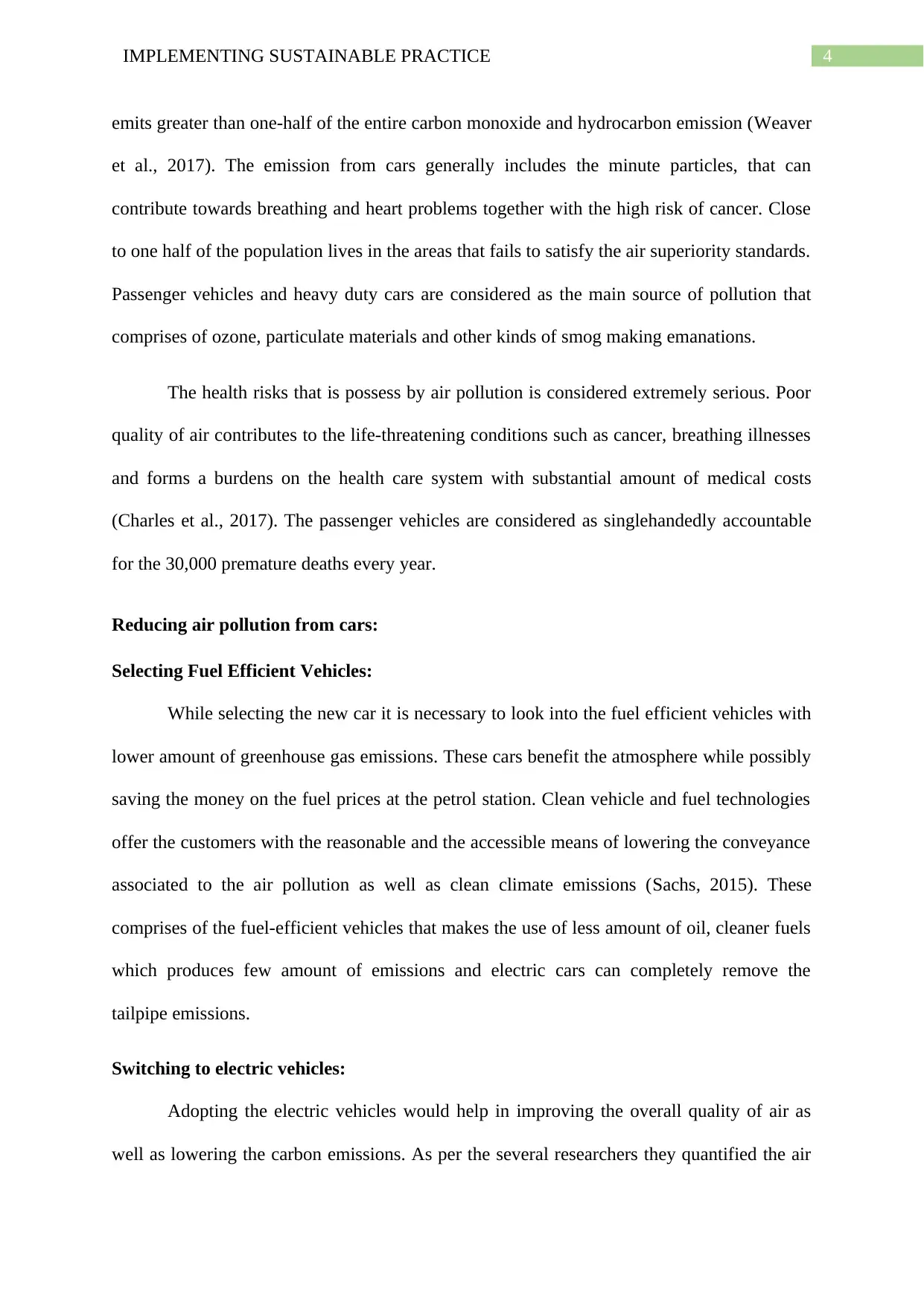
4IMPLEMENTING SUSTAINABLE PRACTICE
emits greater than one-half of the entire carbon monoxide and hydrocarbon emission (Weaver
et al., 2017). The emission from cars generally includes the minute particles, that can
contribute towards breathing and heart problems together with the high risk of cancer. Close
to one half of the population lives in the areas that fails to satisfy the air superiority standards.
Passenger vehicles and heavy duty cars are considered as the main source of pollution that
comprises of ozone, particulate materials and other kinds of smog making emanations.
The health risks that is possess by air pollution is considered extremely serious. Poor
quality of air contributes to the life-threatening conditions such as cancer, breathing illnesses
and forms a burdens on the health care system with substantial amount of medical costs
(Charles et al., 2017). The passenger vehicles are considered as singlehandedly accountable
for the 30,000 premature deaths every year.
Reducing air pollution from cars:
Selecting Fuel Efficient Vehicles:
While selecting the new car it is necessary to look into the fuel efficient vehicles with
lower amount of greenhouse gas emissions. These cars benefit the atmosphere while possibly
saving the money on the fuel prices at the petrol station. Clean vehicle and fuel technologies
offer the customers with the reasonable and the accessible means of lowering the conveyance
associated to the air pollution as well as clean climate emissions (Sachs, 2015). These
comprises of the fuel-efficient vehicles that makes the use of less amount of oil, cleaner fuels
which produces few amount of emissions and electric cars can completely remove the
tailpipe emissions.
Switching to electric vehicles:
Adopting the electric vehicles would help in improving the overall quality of air as
well as lowering the carbon emissions. As per the several researchers they quantified the air
emits greater than one-half of the entire carbon monoxide and hydrocarbon emission (Weaver
et al., 2017). The emission from cars generally includes the minute particles, that can
contribute towards breathing and heart problems together with the high risk of cancer. Close
to one half of the population lives in the areas that fails to satisfy the air superiority standards.
Passenger vehicles and heavy duty cars are considered as the main source of pollution that
comprises of ozone, particulate materials and other kinds of smog making emanations.
The health risks that is possess by air pollution is considered extremely serious. Poor
quality of air contributes to the life-threatening conditions such as cancer, breathing illnesses
and forms a burdens on the health care system with substantial amount of medical costs
(Charles et al., 2017). The passenger vehicles are considered as singlehandedly accountable
for the 30,000 premature deaths every year.
Reducing air pollution from cars:
Selecting Fuel Efficient Vehicles:
While selecting the new car it is necessary to look into the fuel efficient vehicles with
lower amount of greenhouse gas emissions. These cars benefit the atmosphere while possibly
saving the money on the fuel prices at the petrol station. Clean vehicle and fuel technologies
offer the customers with the reasonable and the accessible means of lowering the conveyance
associated to the air pollution as well as clean climate emissions (Sachs, 2015). These
comprises of the fuel-efficient vehicles that makes the use of less amount of oil, cleaner fuels
which produces few amount of emissions and electric cars can completely remove the
tailpipe emissions.
Switching to electric vehicles:
Adopting the electric vehicles would help in improving the overall quality of air as
well as lowering the carbon emissions. As per the several researchers they quantified the air
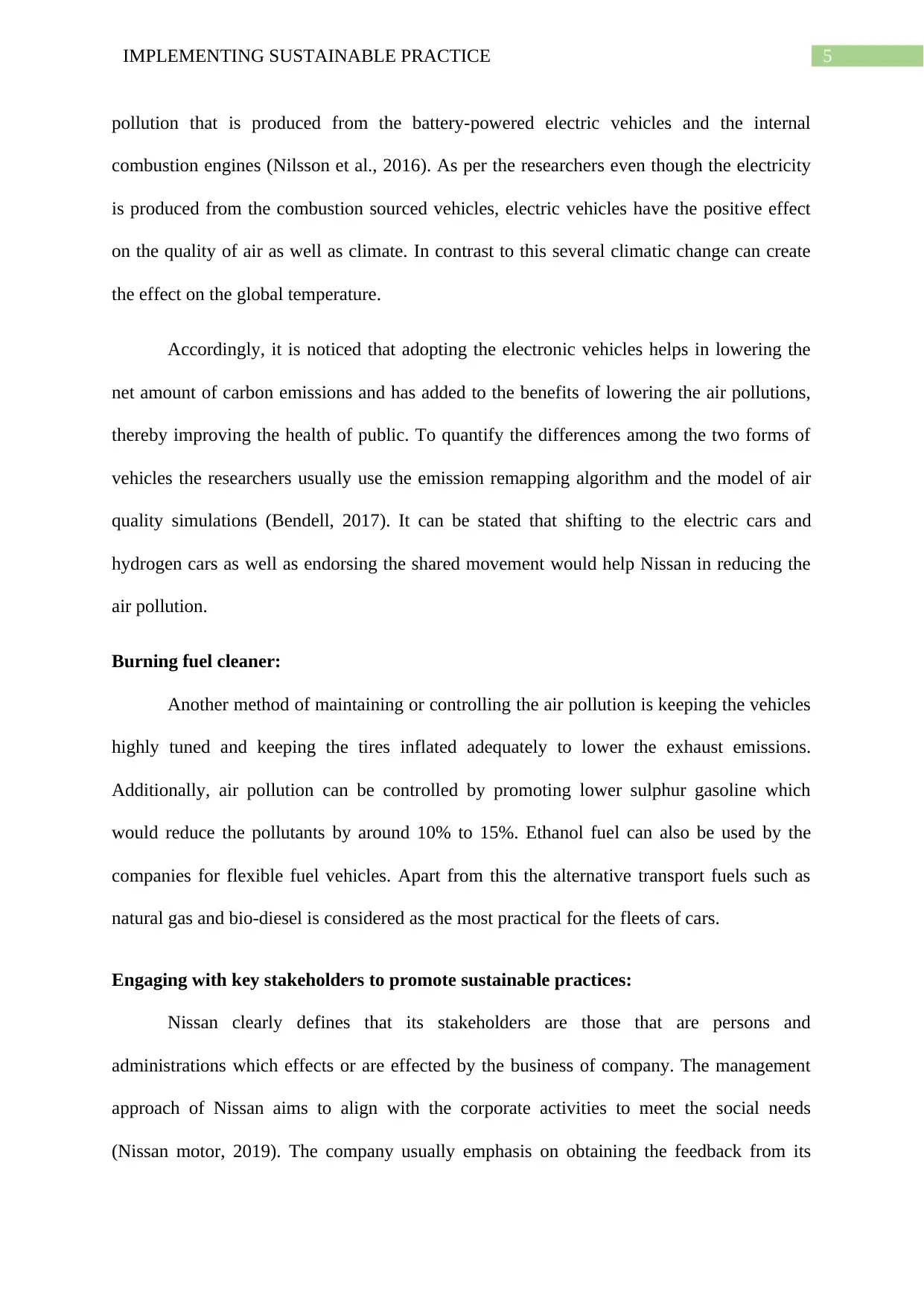
5IMPLEMENTING SUSTAINABLE PRACTICE
pollution that is produced from the battery-powered electric vehicles and the internal
combustion engines (Nilsson et al., 2016). As per the researchers even though the electricity
is produced from the combustion sourced vehicles, electric vehicles have the positive effect
on the quality of air as well as climate. In contrast to this several climatic change can create
the effect on the global temperature.
Accordingly, it is noticed that adopting the electronic vehicles helps in lowering the
net amount of carbon emissions and has added to the benefits of lowering the air pollutions,
thereby improving the health of public. To quantify the differences among the two forms of
vehicles the researchers usually use the emission remapping algorithm and the model of air
quality simulations (Bendell, 2017). It can be stated that shifting to the electric cars and
hydrogen cars as well as endorsing the shared movement would help Nissan in reducing the
air pollution.
Burning fuel cleaner:
Another method of maintaining or controlling the air pollution is keeping the vehicles
highly tuned and keeping the tires inflated adequately to lower the exhaust emissions.
Additionally, air pollution can be controlled by promoting lower sulphur gasoline which
would reduce the pollutants by around 10% to 15%. Ethanol fuel can also be used by the
companies for flexible fuel vehicles. Apart from this the alternative transport fuels such as
natural gas and bio-diesel is considered as the most practical for the fleets of cars.
Engaging with key stakeholders to promote sustainable practices:
Nissan clearly defines that its stakeholders are those that are persons and
administrations which effects or are effected by the business of company. The management
approach of Nissan aims to align with the corporate activities to meet the social needs
(Nissan motor, 2019). The company usually emphasis on obtaining the feedback from its
pollution that is produced from the battery-powered electric vehicles and the internal
combustion engines (Nilsson et al., 2016). As per the researchers even though the electricity
is produced from the combustion sourced vehicles, electric vehicles have the positive effect
on the quality of air as well as climate. In contrast to this several climatic change can create
the effect on the global temperature.
Accordingly, it is noticed that adopting the electronic vehicles helps in lowering the
net amount of carbon emissions and has added to the benefits of lowering the air pollutions,
thereby improving the health of public. To quantify the differences among the two forms of
vehicles the researchers usually use the emission remapping algorithm and the model of air
quality simulations (Bendell, 2017). It can be stated that shifting to the electric cars and
hydrogen cars as well as endorsing the shared movement would help Nissan in reducing the
air pollution.
Burning fuel cleaner:
Another method of maintaining or controlling the air pollution is keeping the vehicles
highly tuned and keeping the tires inflated adequately to lower the exhaust emissions.
Additionally, air pollution can be controlled by promoting lower sulphur gasoline which
would reduce the pollutants by around 10% to 15%. Ethanol fuel can also be used by the
companies for flexible fuel vehicles. Apart from this the alternative transport fuels such as
natural gas and bio-diesel is considered as the most practical for the fleets of cars.
Engaging with key stakeholders to promote sustainable practices:
Nissan clearly defines that its stakeholders are those that are persons and
administrations which effects or are effected by the business of company. The management
approach of Nissan aims to align with the corporate activities to meet the social needs
(Nissan motor, 2019). The company usually emphasis on obtaining the feedback from its
⊘ This is a preview!⊘
Do you want full access?
Subscribe today to unlock all pages.

Trusted by 1+ million students worldwide
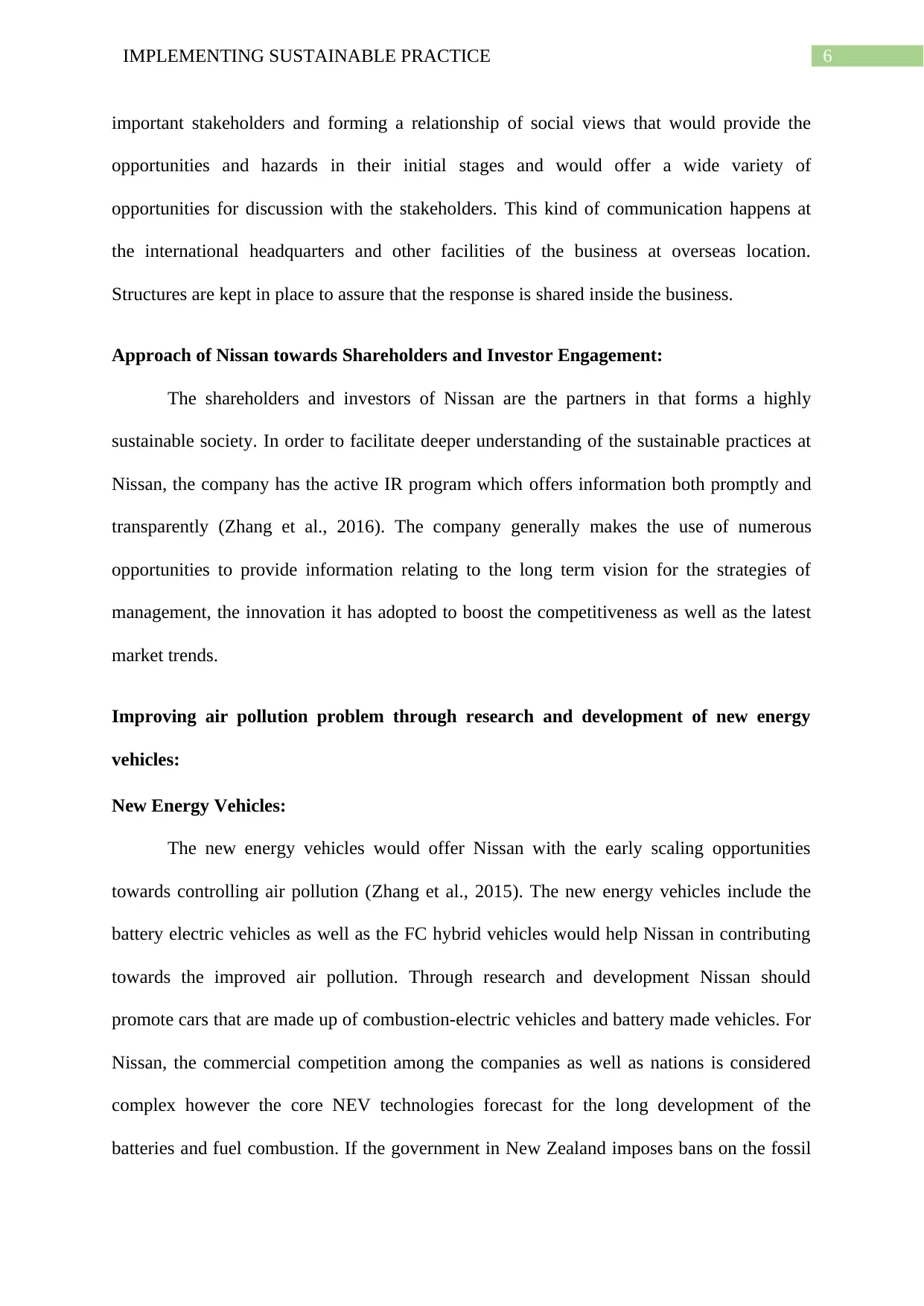
6IMPLEMENTING SUSTAINABLE PRACTICE
important stakeholders and forming a relationship of social views that would provide the
opportunities and hazards in their initial stages and would offer a wide variety of
opportunities for discussion with the stakeholders. This kind of communication happens at
the international headquarters and other facilities of the business at overseas location.
Structures are kept in place to assure that the response is shared inside the business.
Approach of Nissan towards Shareholders and Investor Engagement:
The shareholders and investors of Nissan are the partners in that forms a highly
sustainable society. In order to facilitate deeper understanding of the sustainable practices at
Nissan, the company has the active IR program which offers information both promptly and
transparently (Zhang et al., 2016). The company generally makes the use of numerous
opportunities to provide information relating to the long term vision for the strategies of
management, the innovation it has adopted to boost the competitiveness as well as the latest
market trends.
Improving air pollution problem through research and development of new energy
vehicles:
New Energy Vehicles:
The new energy vehicles would offer Nissan with the early scaling opportunities
towards controlling air pollution (Zhang et al., 2015). The new energy vehicles include the
battery electric vehicles as well as the FC hybrid vehicles would help Nissan in contributing
towards the improved air pollution. Through research and development Nissan should
promote cars that are made up of combustion-electric vehicles and battery made vehicles. For
Nissan, the commercial competition among the companies as well as nations is considered
complex however the core NEV technologies forecast for the long development of the
batteries and fuel combustion. If the government in New Zealand imposes bans on the fossil
important stakeholders and forming a relationship of social views that would provide the
opportunities and hazards in their initial stages and would offer a wide variety of
opportunities for discussion with the stakeholders. This kind of communication happens at
the international headquarters and other facilities of the business at overseas location.
Structures are kept in place to assure that the response is shared inside the business.
Approach of Nissan towards Shareholders and Investor Engagement:
The shareholders and investors of Nissan are the partners in that forms a highly
sustainable society. In order to facilitate deeper understanding of the sustainable practices at
Nissan, the company has the active IR program which offers information both promptly and
transparently (Zhang et al., 2016). The company generally makes the use of numerous
opportunities to provide information relating to the long term vision for the strategies of
management, the innovation it has adopted to boost the competitiveness as well as the latest
market trends.
Improving air pollution problem through research and development of new energy
vehicles:
New Energy Vehicles:
The new energy vehicles would offer Nissan with the early scaling opportunities
towards controlling air pollution (Zhang et al., 2015). The new energy vehicles include the
battery electric vehicles as well as the FC hybrid vehicles would help Nissan in contributing
towards the improved air pollution. Through research and development Nissan should
promote cars that are made up of combustion-electric vehicles and battery made vehicles. For
Nissan, the commercial competition among the companies as well as nations is considered
complex however the core NEV technologies forecast for the long development of the
batteries and fuel combustion. If the government in New Zealand imposes bans on the fossil
Paraphrase This Document
Need a fresh take? Get an instant paraphrase of this document with our AI Paraphraser
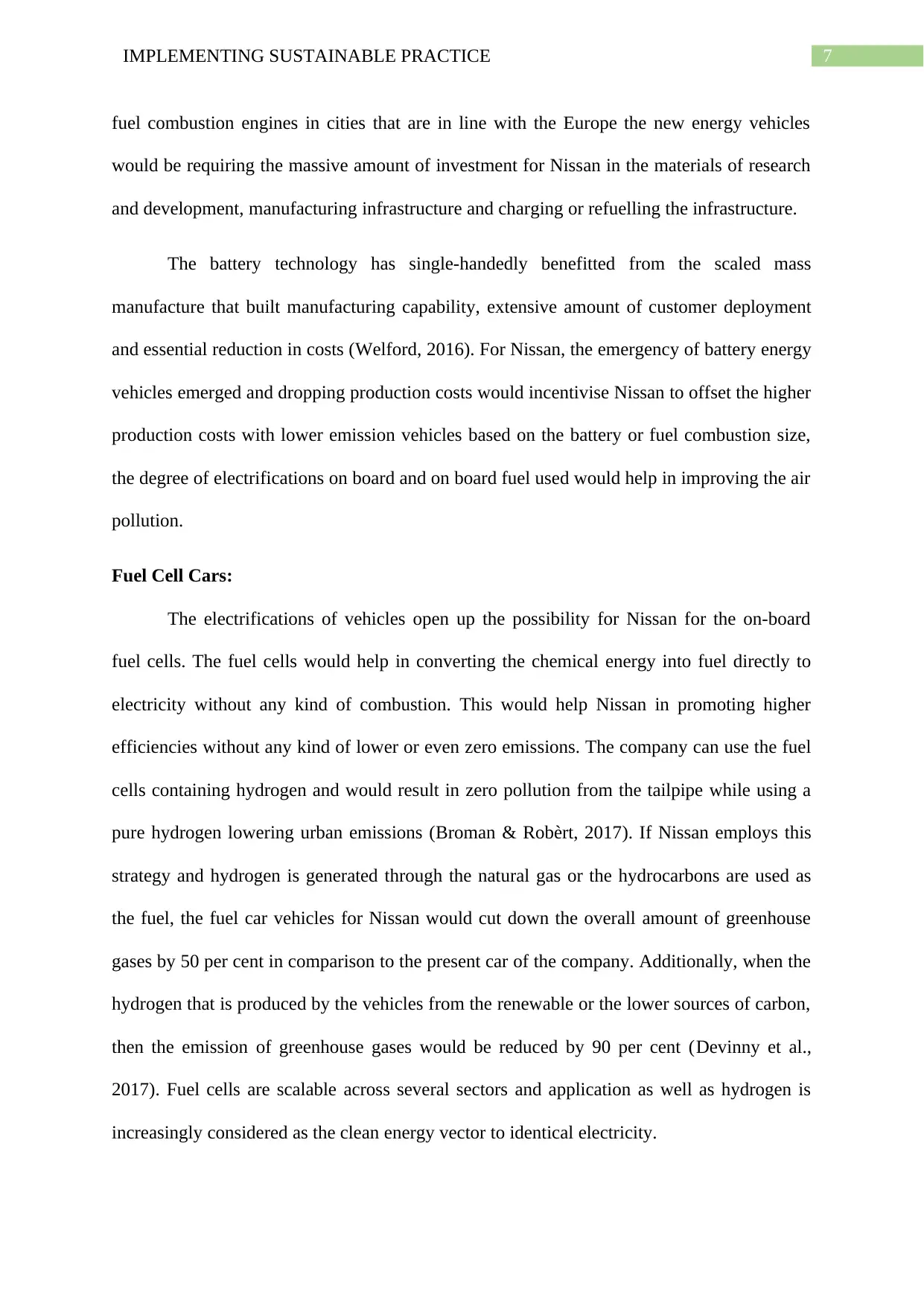
7IMPLEMENTING SUSTAINABLE PRACTICE
fuel combustion engines in cities that are in line with the Europe the new energy vehicles
would be requiring the massive amount of investment for Nissan in the materials of research
and development, manufacturing infrastructure and charging or refuelling the infrastructure.
The battery technology has single-handedly benefitted from the scaled mass
manufacture that built manufacturing capability, extensive amount of customer deployment
and essential reduction in costs (Welford, 2016). For Nissan, the emergency of battery energy
vehicles emerged and dropping production costs would incentivise Nissan to offset the higher
production costs with lower emission vehicles based on the battery or fuel combustion size,
the degree of electrifications on board and on board fuel used would help in improving the air
pollution.
Fuel Cell Cars:
The electrifications of vehicles open up the possibility for Nissan for the on-board
fuel cells. The fuel cells would help in converting the chemical energy into fuel directly to
electricity without any kind of combustion. This would help Nissan in promoting higher
efficiencies without any kind of lower or even zero emissions. The company can use the fuel
cells containing hydrogen and would result in zero pollution from the tailpipe while using a
pure hydrogen lowering urban emissions (Broman & Robèrt, 2017). If Nissan employs this
strategy and hydrogen is generated through the natural gas or the hydrocarbons are used as
the fuel, the fuel car vehicles for Nissan would cut down the overall amount of greenhouse
gases by 50 per cent in comparison to the present car of the company. Additionally, when the
hydrogen that is produced by the vehicles from the renewable or the lower sources of carbon,
then the emission of greenhouse gases would be reduced by 90 per cent (Devinny et al.,
2017). Fuel cells are scalable across several sectors and application as well as hydrogen is
increasingly considered as the clean energy vector to identical electricity.
fuel combustion engines in cities that are in line with the Europe the new energy vehicles
would be requiring the massive amount of investment for Nissan in the materials of research
and development, manufacturing infrastructure and charging or refuelling the infrastructure.
The battery technology has single-handedly benefitted from the scaled mass
manufacture that built manufacturing capability, extensive amount of customer deployment
and essential reduction in costs (Welford, 2016). For Nissan, the emergency of battery energy
vehicles emerged and dropping production costs would incentivise Nissan to offset the higher
production costs with lower emission vehicles based on the battery or fuel combustion size,
the degree of electrifications on board and on board fuel used would help in improving the air
pollution.
Fuel Cell Cars:
The electrifications of vehicles open up the possibility for Nissan for the on-board
fuel cells. The fuel cells would help in converting the chemical energy into fuel directly to
electricity without any kind of combustion. This would help Nissan in promoting higher
efficiencies without any kind of lower or even zero emissions. The company can use the fuel
cells containing hydrogen and would result in zero pollution from the tailpipe while using a
pure hydrogen lowering urban emissions (Broman & Robèrt, 2017). If Nissan employs this
strategy and hydrogen is generated through the natural gas or the hydrocarbons are used as
the fuel, the fuel car vehicles for Nissan would cut down the overall amount of greenhouse
gases by 50 per cent in comparison to the present car of the company. Additionally, when the
hydrogen that is produced by the vehicles from the renewable or the lower sources of carbon,
then the emission of greenhouse gases would be reduced by 90 per cent (Devinny et al.,
2017). Fuel cells are scalable across several sectors and application as well as hydrogen is
increasingly considered as the clean energy vector to identical electricity.
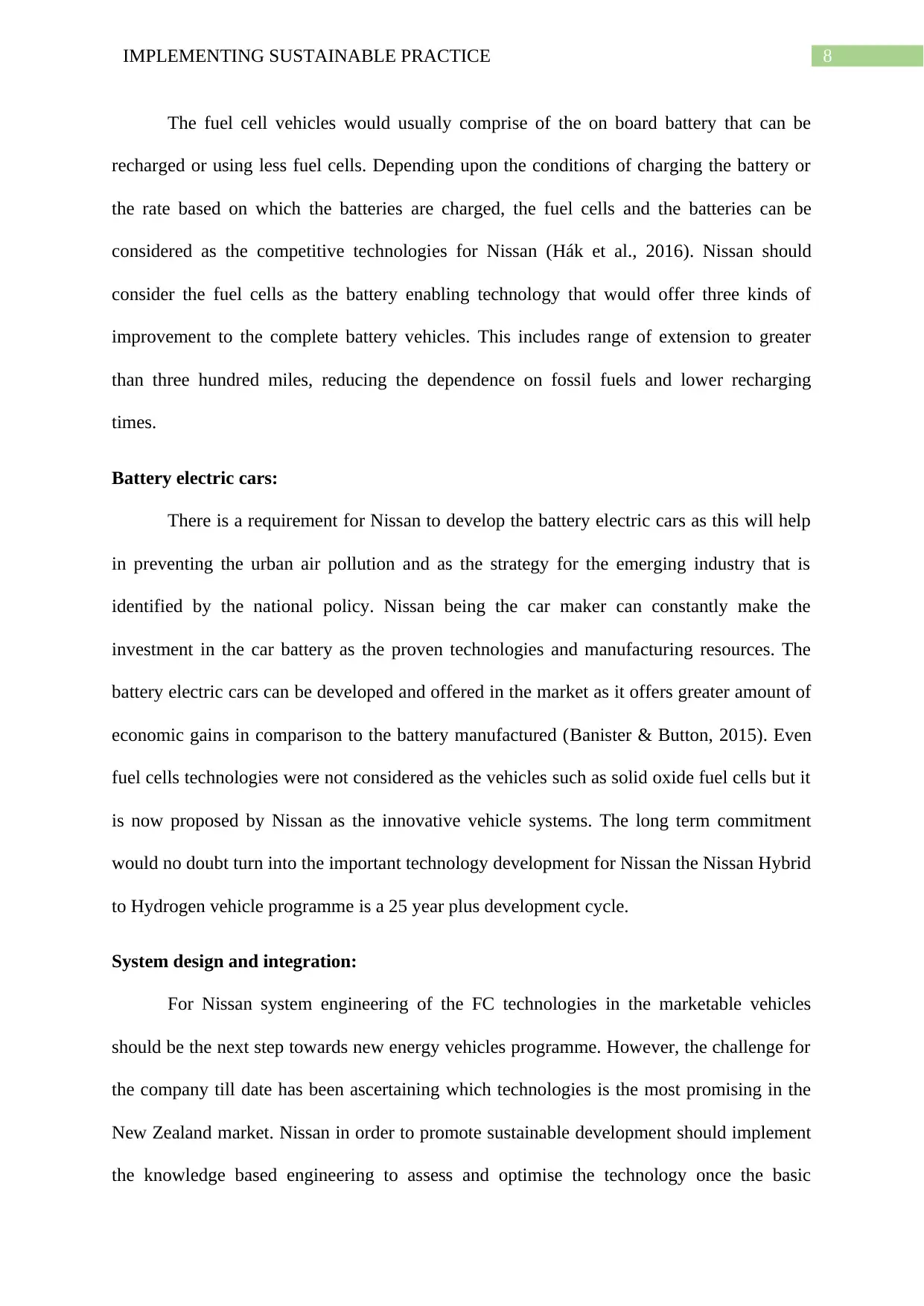
8IMPLEMENTING SUSTAINABLE PRACTICE
The fuel cell vehicles would usually comprise of the on board battery that can be
recharged or using less fuel cells. Depending upon the conditions of charging the battery or
the rate based on which the batteries are charged, the fuel cells and the batteries can be
considered as the competitive technologies for Nissan (Hák et al., 2016). Nissan should
consider the fuel cells as the battery enabling technology that would offer three kinds of
improvement to the complete battery vehicles. This includes range of extension to greater
than three hundred miles, reducing the dependence on fossil fuels and lower recharging
times.
Battery electric cars:
There is a requirement for Nissan to develop the battery electric cars as this will help
in preventing the urban air pollution and as the strategy for the emerging industry that is
identified by the national policy. Nissan being the car maker can constantly make the
investment in the car battery as the proven technologies and manufacturing resources. The
battery electric cars can be developed and offered in the market as it offers greater amount of
economic gains in comparison to the battery manufactured (Banister & Button, 2015). Even
fuel cells technologies were not considered as the vehicles such as solid oxide fuel cells but it
is now proposed by Nissan as the innovative vehicle systems. The long term commitment
would no doubt turn into the important technology development for Nissan the Nissan Hybrid
to Hydrogen vehicle programme is a 25 year plus development cycle.
System design and integration:
For Nissan system engineering of the FC technologies in the marketable vehicles
should be the next step towards new energy vehicles programme. However, the challenge for
the company till date has been ascertaining which technologies is the most promising in the
New Zealand market. Nissan in order to promote sustainable development should implement
the knowledge based engineering to assess and optimise the technology once the basic
The fuel cell vehicles would usually comprise of the on board battery that can be
recharged or using less fuel cells. Depending upon the conditions of charging the battery or
the rate based on which the batteries are charged, the fuel cells and the batteries can be
considered as the competitive technologies for Nissan (Hák et al., 2016). Nissan should
consider the fuel cells as the battery enabling technology that would offer three kinds of
improvement to the complete battery vehicles. This includes range of extension to greater
than three hundred miles, reducing the dependence on fossil fuels and lower recharging
times.
Battery electric cars:
There is a requirement for Nissan to develop the battery electric cars as this will help
in preventing the urban air pollution and as the strategy for the emerging industry that is
identified by the national policy. Nissan being the car maker can constantly make the
investment in the car battery as the proven technologies and manufacturing resources. The
battery electric cars can be developed and offered in the market as it offers greater amount of
economic gains in comparison to the battery manufactured (Banister & Button, 2015). Even
fuel cells technologies were not considered as the vehicles such as solid oxide fuel cells but it
is now proposed by Nissan as the innovative vehicle systems. The long term commitment
would no doubt turn into the important technology development for Nissan the Nissan Hybrid
to Hydrogen vehicle programme is a 25 year plus development cycle.
System design and integration:
For Nissan system engineering of the FC technologies in the marketable vehicles
should be the next step towards new energy vehicles programme. However, the challenge for
the company till date has been ascertaining which technologies is the most promising in the
New Zealand market. Nissan in order to promote sustainable development should implement
the knowledge based engineering to assess and optimise the technology once the basic
⊘ This is a preview!⊘
Do you want full access?
Subscribe today to unlock all pages.

Trusted by 1+ million students worldwide
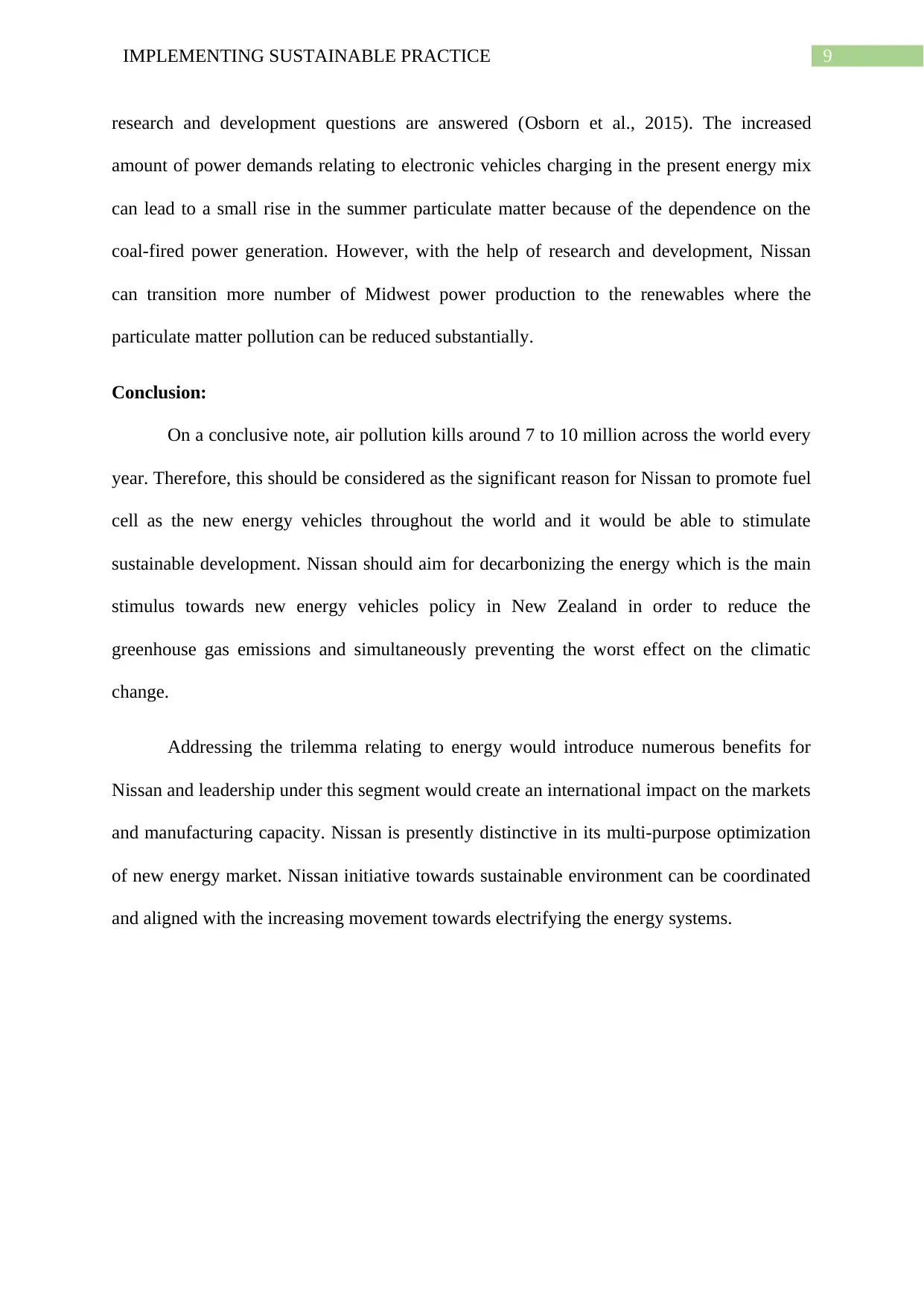
9IMPLEMENTING SUSTAINABLE PRACTICE
research and development questions are answered (Osborn et al., 2015). The increased
amount of power demands relating to electronic vehicles charging in the present energy mix
can lead to a small rise in the summer particulate matter because of the dependence on the
coal-fired power generation. However, with the help of research and development, Nissan
can transition more number of Midwest power production to the renewables where the
particulate matter pollution can be reduced substantially.
Conclusion:
On a conclusive note, air pollution kills around 7 to 10 million across the world every
year. Therefore, this should be considered as the significant reason for Nissan to promote fuel
cell as the new energy vehicles throughout the world and it would be able to stimulate
sustainable development. Nissan should aim for decarbonizing the energy which is the main
stimulus towards new energy vehicles policy in New Zealand in order to reduce the
greenhouse gas emissions and simultaneously preventing the worst effect on the climatic
change.
Addressing the trilemma relating to energy would introduce numerous benefits for
Nissan and leadership under this segment would create an international impact on the markets
and manufacturing capacity. Nissan is presently distinctive in its multi-purpose optimization
of new energy market. Nissan initiative towards sustainable environment can be coordinated
and aligned with the increasing movement towards electrifying the energy systems.
research and development questions are answered (Osborn et al., 2015). The increased
amount of power demands relating to electronic vehicles charging in the present energy mix
can lead to a small rise in the summer particulate matter because of the dependence on the
coal-fired power generation. However, with the help of research and development, Nissan
can transition more number of Midwest power production to the renewables where the
particulate matter pollution can be reduced substantially.
Conclusion:
On a conclusive note, air pollution kills around 7 to 10 million across the world every
year. Therefore, this should be considered as the significant reason for Nissan to promote fuel
cell as the new energy vehicles throughout the world and it would be able to stimulate
sustainable development. Nissan should aim for decarbonizing the energy which is the main
stimulus towards new energy vehicles policy in New Zealand in order to reduce the
greenhouse gas emissions and simultaneously preventing the worst effect on the climatic
change.
Addressing the trilemma relating to energy would introduce numerous benefits for
Nissan and leadership under this segment would create an international impact on the markets
and manufacturing capacity. Nissan is presently distinctive in its multi-purpose optimization
of new energy market. Nissan initiative towards sustainable environment can be coordinated
and aligned with the increasing movement towards electrifying the energy systems.
Paraphrase This Document
Need a fresh take? Get an instant paraphrase of this document with our AI Paraphraser
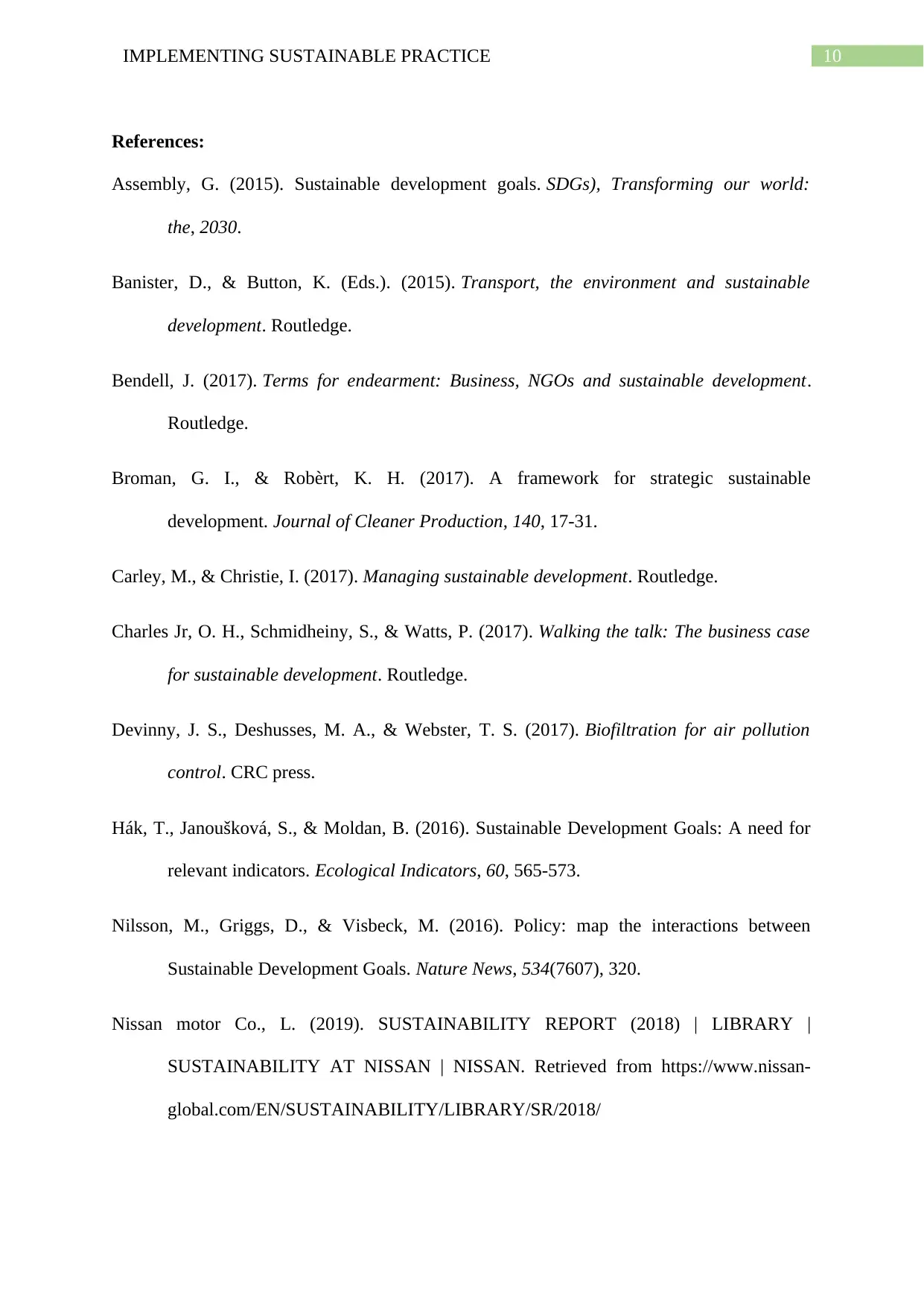
10IMPLEMENTING SUSTAINABLE PRACTICE
References:
Assembly, G. (2015). Sustainable development goals. SDGs), Transforming our world:
the, 2030.
Banister, D., & Button, K. (Eds.). (2015). Transport, the environment and sustainable
development. Routledge.
Bendell, J. (2017). Terms for endearment: Business, NGOs and sustainable development.
Routledge.
Broman, G. I., & Robèrt, K. H. (2017). A framework for strategic sustainable
development. Journal of Cleaner Production, 140, 17-31.
Carley, M., & Christie, I. (2017). Managing sustainable development. Routledge.
Charles Jr, O. H., Schmidheiny, S., & Watts, P. (2017). Walking the talk: The business case
for sustainable development. Routledge.
Devinny, J. S., Deshusses, M. A., & Webster, T. S. (2017). Biofiltration for air pollution
control. CRC press.
Hák, T., Janoušková, S., & Moldan, B. (2016). Sustainable Development Goals: A need for
relevant indicators. Ecological Indicators, 60, 565-573.
Nilsson, M., Griggs, D., & Visbeck, M. (2016). Policy: map the interactions between
Sustainable Development Goals. Nature News, 534(7607), 320.
Nissan motor Co., L. (2019). SUSTAINABILITY REPORT (2018) | LIBRARY |
SUSTAINABILITY AT NISSAN | NISSAN. Retrieved from https://www.nissan-
global.com/EN/SUSTAINABILITY/LIBRARY/SR/2018/
References:
Assembly, G. (2015). Sustainable development goals. SDGs), Transforming our world:
the, 2030.
Banister, D., & Button, K. (Eds.). (2015). Transport, the environment and sustainable
development. Routledge.
Bendell, J. (2017). Terms for endearment: Business, NGOs and sustainable development.
Routledge.
Broman, G. I., & Robèrt, K. H. (2017). A framework for strategic sustainable
development. Journal of Cleaner Production, 140, 17-31.
Carley, M., & Christie, I. (2017). Managing sustainable development. Routledge.
Charles Jr, O. H., Schmidheiny, S., & Watts, P. (2017). Walking the talk: The business case
for sustainable development. Routledge.
Devinny, J. S., Deshusses, M. A., & Webster, T. S. (2017). Biofiltration for air pollution
control. CRC press.
Hák, T., Janoušková, S., & Moldan, B. (2016). Sustainable Development Goals: A need for
relevant indicators. Ecological Indicators, 60, 565-573.
Nilsson, M., Griggs, D., & Visbeck, M. (2016). Policy: map the interactions between
Sustainable Development Goals. Nature News, 534(7607), 320.
Nissan motor Co., L. (2019). SUSTAINABILITY REPORT (2018) | LIBRARY |
SUSTAINABILITY AT NISSAN | NISSAN. Retrieved from https://www.nissan-
global.com/EN/SUSTAINABILITY/LIBRARY/SR/2018/
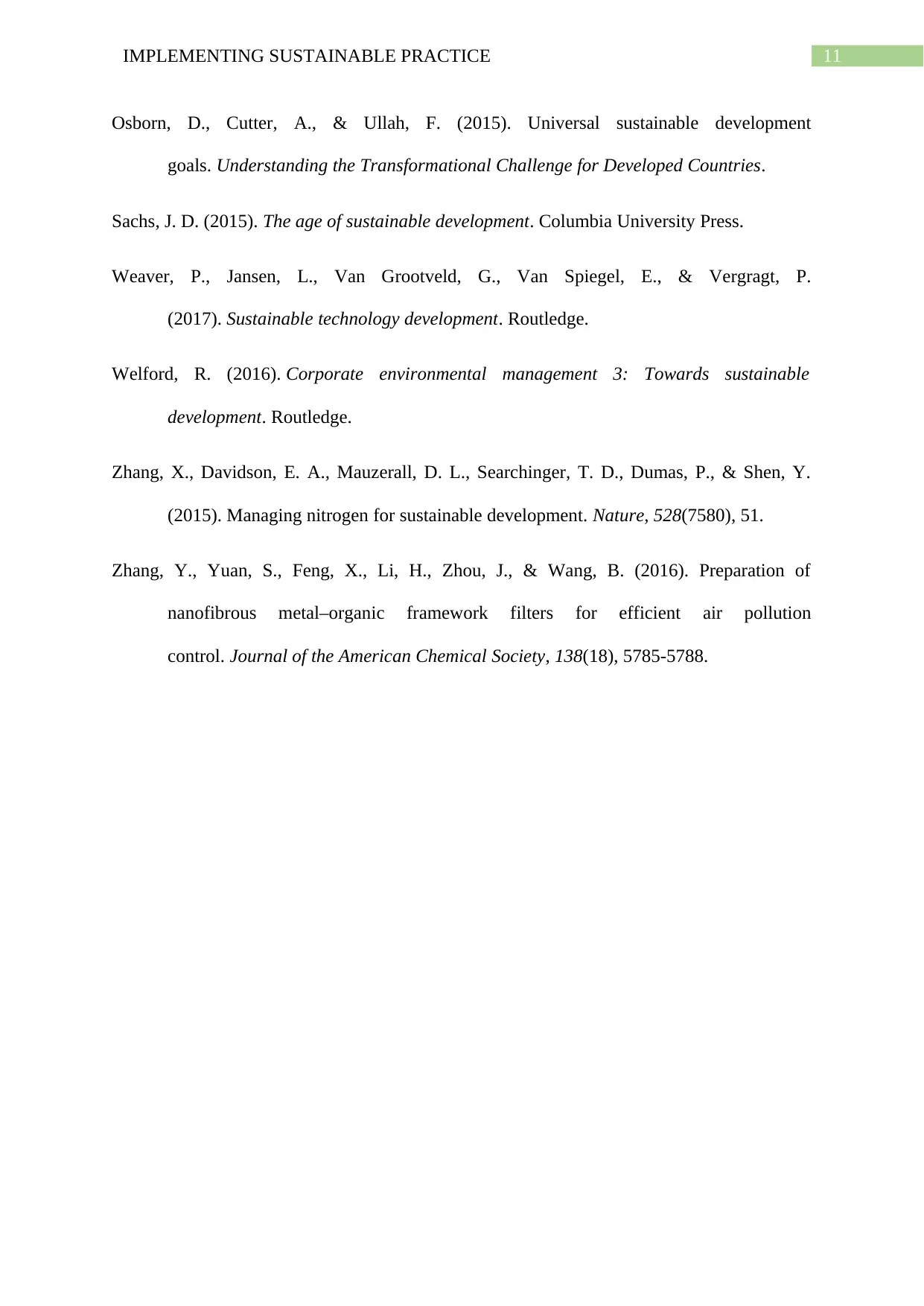
11IMPLEMENTING SUSTAINABLE PRACTICE
Osborn, D., Cutter, A., & Ullah, F. (2015). Universal sustainable development
goals. Understanding the Transformational Challenge for Developed Countries.
Sachs, J. D. (2015). The age of sustainable development. Columbia University Press.
Weaver, P., Jansen, L., Van Grootveld, G., Van Spiegel, E., & Vergragt, P.
(2017). Sustainable technology development. Routledge.
Welford, R. (2016). Corporate environmental management 3: Towards sustainable
development. Routledge.
Zhang, X., Davidson, E. A., Mauzerall, D. L., Searchinger, T. D., Dumas, P., & Shen, Y.
(2015). Managing nitrogen for sustainable development. Nature, 528(7580), 51.
Zhang, Y., Yuan, S., Feng, X., Li, H., Zhou, J., & Wang, B. (2016). Preparation of
nanofibrous metal–organic framework filters for efficient air pollution
control. Journal of the American Chemical Society, 138(18), 5785-5788.
Osborn, D., Cutter, A., & Ullah, F. (2015). Universal sustainable development
goals. Understanding the Transformational Challenge for Developed Countries.
Sachs, J. D. (2015). The age of sustainable development. Columbia University Press.
Weaver, P., Jansen, L., Van Grootveld, G., Van Spiegel, E., & Vergragt, P.
(2017). Sustainable technology development. Routledge.
Welford, R. (2016). Corporate environmental management 3: Towards sustainable
development. Routledge.
Zhang, X., Davidson, E. A., Mauzerall, D. L., Searchinger, T. D., Dumas, P., & Shen, Y.
(2015). Managing nitrogen for sustainable development. Nature, 528(7580), 51.
Zhang, Y., Yuan, S., Feng, X., Li, H., Zhou, J., & Wang, B. (2016). Preparation of
nanofibrous metal–organic framework filters for efficient air pollution
control. Journal of the American Chemical Society, 138(18), 5785-5788.
⊘ This is a preview!⊘
Do you want full access?
Subscribe today to unlock all pages.

Trusted by 1+ million students worldwide
1 out of 12
Related Documents
Your All-in-One AI-Powered Toolkit for Academic Success.
+13062052269
info@desklib.com
Available 24*7 on WhatsApp / Email
![[object Object]](/_next/static/media/star-bottom.7253800d.svg)
Unlock your academic potential
Copyright © 2020–2025 A2Z Services. All Rights Reserved. Developed and managed by ZUCOL.





